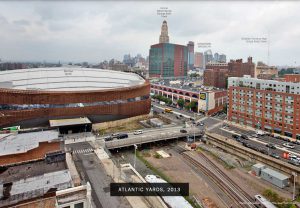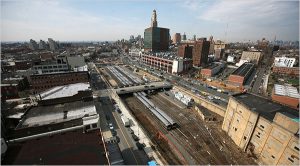The juxtaposition of the old and the new of gentrification impacts negatively to the community of Atlantic ST- Barclay’s Center. The old and the new creates another juxtaposition which is the poor and the rich. While I was looking up pictures of Barclays Center, I was filled with nostalgia. Seeing old picture of Atlantic yard (before Barclay Center) and the past and present pictures brought back memories. It is astonishing to me because my memory of Atlantic Yard is vivid and the gentrification of this community is obvious to see. There are still brown-stoned buildings that have been in this community for so long, yet the luxury building seems to be overtaking the community at a fast pace. According to the website Merriam Webster defines juxtaposition as, the act or an instance of placing two or more things side by side often to compare or contrast or to create an interesting effect. The old and the new of this community is a great example of a juxtaposed community. As I walk throughout Atlantic Yard, I can see that the old and the new is not just about the buildings, but also the people that live there.
The brown-stone buildings that are still left in Atlantic, screams the old Brooklyn. Seeing the luxury buildings being built all around the community, screams gentrification. The brown-stone buildings that are trying to survive in a community that is being renovated, is disheartening. It makes me wonder about the old residents that were kicked out or are in the process of being kicked out of their homes. A community that is no longer bringing them an authentic culture. A neighborhood that is becoming even more hard to survive financially than before. This reminds me of what Mr. Self said, from “A Literary Visitor Strolls in From the Airport” by Charles McGrath. He said, “There is a deep sadness to American poverty, greater than the sadness of any kind. It’s because America has such an ideology of success” (3). This quote can relate to Atlantic Ave because the poverty of the old residents is not being seen and it is being brushed away. The ideology of it, is the success of a neighborhood that is being gentrified. The success of the gentrification would be the amount of money it will make for the privileged.
The luxury buildings are being constructed for it to look modern and is creating a new Brooklyn. This is targeting new residents and bringing them the things they expect to see in a community they are moving into. The changes I have seen are the new shops that have been opened and targeting the pockets of the new residents. In “City Limits” by Colson Whitehead, he said “I never got a chance to say goodbye to some of my buildings” (3). This is a feeling that I share with the author because the New Yorkers that were born and raised here know that feeling of not having a chance to say goodbye to the memories they shared. Old stores are being closed in order for new stores to be open. This is the flow of gentrification and it creates another juxtaposition within the old and the new which is the poor and the rich.
The creation of the juxtaposition of the poor and the rich is once again related to the old and the new due to the gentrification of the neighborhood. The poor are the old residents that can no longer afford to live in their neighborhood. The rich are the ones that are creating new plans for the neighborhood and profiting from it. While the rich profits from their new plans, they create a contrasting effect. It is contrasting the residents of this neighborhood. The effect of it all is the topic of gentrification. It is noticeable that the old residents are trying to fight it, but it is not a successful fight after all. Whitehead mentions in his article, “Maybe we become New Yorkers the day we realize that New York will go on without us” (4). This is the realization that I made as I walked the streets of the juxtaposed neighborhood of Atlantic Ave- Barclays Center. No matter how hard we try for a neighborhood not to change, it is bound to happen. There is no turning back once gentrification has set their eyes on a certain neighborhood, such as this one.
Nostalgia is a feeling that tries to hold on to the old, but it is not healthy to do so. The old and the new are linked because change is the contrasting effect of it. From this juxtaposition it may create a financial one which is the poor and the rich. Especially coming from a juxtaposed neighborhood that is having a dramatic change every day. There is always going to be mixed feelings when I walk by Atlantic Ave- Barclays Center. I hold dearly to the moments I would pass by there, as a child. These are the memories that I will hold and be able to observe the changes as a spectator. As Whitehead mentioned, “No matter how long you have been here, you are a New Yorker the first time you say, That used to be Munsey’s or That used to be the Tic Toc Lounge” (3). Memories are just memories and there is no way of going back to the old, once the new has started to make a move. Hopefully, I would have a chance to say goodbye to those brown-stone buildings that yells old Brooklyn! And welcome with a broken heart the luxury buildings. The biggest step is to accept the change of Atlantic Ave- Barclays Center.
Cite List
- Colson Whitehead, “City Limits”; The Colossus of New York
- Charles McGrath,” A Literary Visitor Strolls in From the Airport”;Books.





